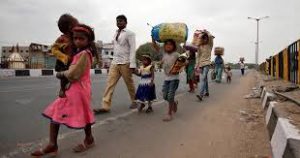The family on Sunday walked with hundreds of others down a highway normally clogged with vehicles, their mouths and noses covered with scarves or handkerchiefs or masks.
In small groups and large crowds, through inner-city lanes and down interstate highways, hundreds of thousands of India’s poorest are slowly making a desperate journey on foot back to their villages in a mass exodus unseen since the days immediately after India’s independence in 1947.
For many, it’s a matter of life and death. Prime Minister Narendra Modi’s order last Tuesday to lock down the country for 21 days to prevent the spread of Covid-19 has dried up work in urban areas, leaving many rural migrants who keep the city moving while making less than $2 a day — construction workers, handymen, food sellers, truck drivers and household help — suddenly wondering how they’ll pay rent or buy food.
“We have to go to our village — we will starve here,” said Rekha Devi as she walked with her husband and two young children down a highway outside of Delhi, heading to see her family some 370 kilometers (270 miles) away. The couple lived on the construction site where they worked, but the job stopped suddenly more than a week ago.
“We haven’t eaten for two days,” Devi said, noting that the little money they had saved quickly ran out. “We are scared of this disease but I think hunger will kill us. We will stay hungry, but how can we watch our children starve?”
The family on Sunday walked with hundreds of others down a highway normally clogged with vehicles, their mouths and noses covered with scarves or handkerchiefs or masks. They clasped their children and belongings — tattered duffel bags stuffed with clothes, buckets filled with cooking utensils, blankets and sheets.
The grim scenes playing out across the nation of 1.3 billion people are some of the worst across the world since the virus crisis shut down much of the global economy. In India, it’s brought back memories of the mass migration sparked by deadly religious riots when the subcontinent was split up after the British left in 1947. These days, however, the divide is largely between those in India with money and those who live month by month, or even day by day.

Leave a Reply